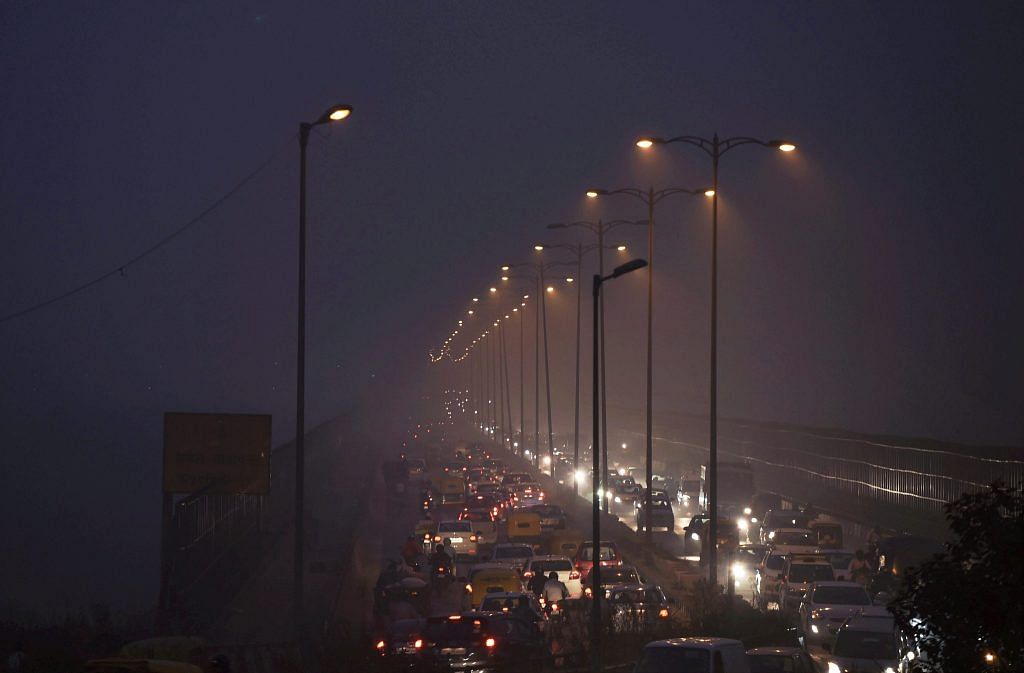There is an urgent need to encourage innovation and educate farmers rather than taking punitive action against already stressed farmers.
It is that time of the year when the residents of Delhi-NCR realise that something is seriously wrong with the air they are breathing and the government needs to do something to address that. A 2016 report of IIT-Kanpur has documented that based on annual emissions (based on a survey conducted between November 2013 and June 2014), road dust is the single largest contributor to air pollution, accounting for 56 per cent of particulate matter 10 (PM10).
Other major contributors to PM10 are concrete batching (10 per cent), industrial point sources (10 per cent) and vehicles (9 per cent). Similarly, top contributors to PM 2.5 emissions are road dust (38 per cent), vehicles (20 per cent), domestic fuel burning (12 per cent) and industrial point sources (11 per cent).
Nitrous oxide emission is caused by industries, mainly power plants (52 per cent), vehicular emissions (36 per cent), DG sets (6 per cent) and aircraft emissions (2 per cent). Carbon mono oxide emissions are caused primarily by vehicles (83 per cent). Ninety per cent of sulfur dioxide emissions are caused by industries, mostly power plants.
Former Union environment minister Anil Dave was on record mentioning that only 20 per cent of Delhi’s pollution can be attributed to stubble burning in adjoining states. Ignoring the evidence of major sources of pollution lying within the NCR, the primary focus shifts every year in October-November to burning of paddy residues by farmers in Punjab, Haryana and Uttar Pradesh. Precious little has been done in past few years to address the sources of air pollution within the NCR, except for odd-even experiment of private vehicles in 2016, that too with umpteen exceptions.
Even simple things like managing Delhi’s borders with adjoining states to enable seamless movement of vehicles has not been attempted and one can see miles-long queues every day on almost all borders.
Due to several policy decisions of the central government taken over the years, Green Revolution and food security concerns, paddy has become a major kharif crop in Punjab and Haryana. Before combine harvesters became popular, the harvesting of paddy was done manually, which left hardly any straw in the field. Now that labour has become expensive, farmers in these states have taken to intensive use of harvesters, which leave about 80 per cent of straw (6-8″ long) on the field. Since wheat has to be sown in most of the fields, the time between harvesting of paddy and sowing of wheat is just about 15-20 days. Farmers, therefore, prefer to burn the straw to save on time and labour cost.
About 20 million tonne of paddy straw is thus burnt within a fortnight. Wheat straw, however, is removed by farmers and it is not burnt as it is used as fodder. Even though the National Green Tribunal and state governments have banned stubble burning, it is unlikely that lakhs of farmers can be penalised for this. When the central government, which has direct control over Delhi Police, could not implement orders of the SC banning the sale of crackers before Diwali, it is too much to expect the state governments of Punjab, Haryana and UP to book lakhs of farmers on charges of stubble burning.
So, is there a solution to this problem? The Bharatiya Kisan Union has demanded that farmers be paid a compensation of Rs 4,000-5,000 per acre. But I do not think this alone can address the problem as labour required for manually taking out stubble will still not be available and it will be difficult to check that farmers are actually removing the stubble. Technology and policy intervention by governments can, however, provide viable solution to this problem.
Happy seeder machines enable farmers to directly sow wheat in paddy fields. Some progressive farmers have been using it, but it has not become mainstream yet. It costs about Rs 1.25 lakh and small and marginal farmers cannot afford to buy it. Therefore, it needs to be subsidised by the state governments and the Centre needs to compensate the states for providing this subsidy to farmers. Scientists at Punjab Agricultural University have also been experimenting with innovative solutions. EnergyHarvest, a technology developed by them, compresses paddy straw into small pellets that are easy to store and transport than bales of straw. The pellets retain carbon and nutrients present in straw and when applied to soil, they can make the soil healthier.
A task force set up by NITI Aayog has projected that a permanent solution can be found with an investment of Rs 11,447 core. It has also recommended investment in energy plants using paddy straw as raw material. There is a need to find resources, encourage innovation and educate farmers rather than taking punitive action against already stressed farmers, who are barely able to recover even their cost from farming operations.
And finally, paddy is not what water-starved Punjab needs to grow in Kharif. Several suggestions have been made to facilitate diversification from paddy to crops needing less water. But that is another story!
The author is retired Secretary, Agriculture, GoI, and is currently visiting senior fellow, ICRIER
